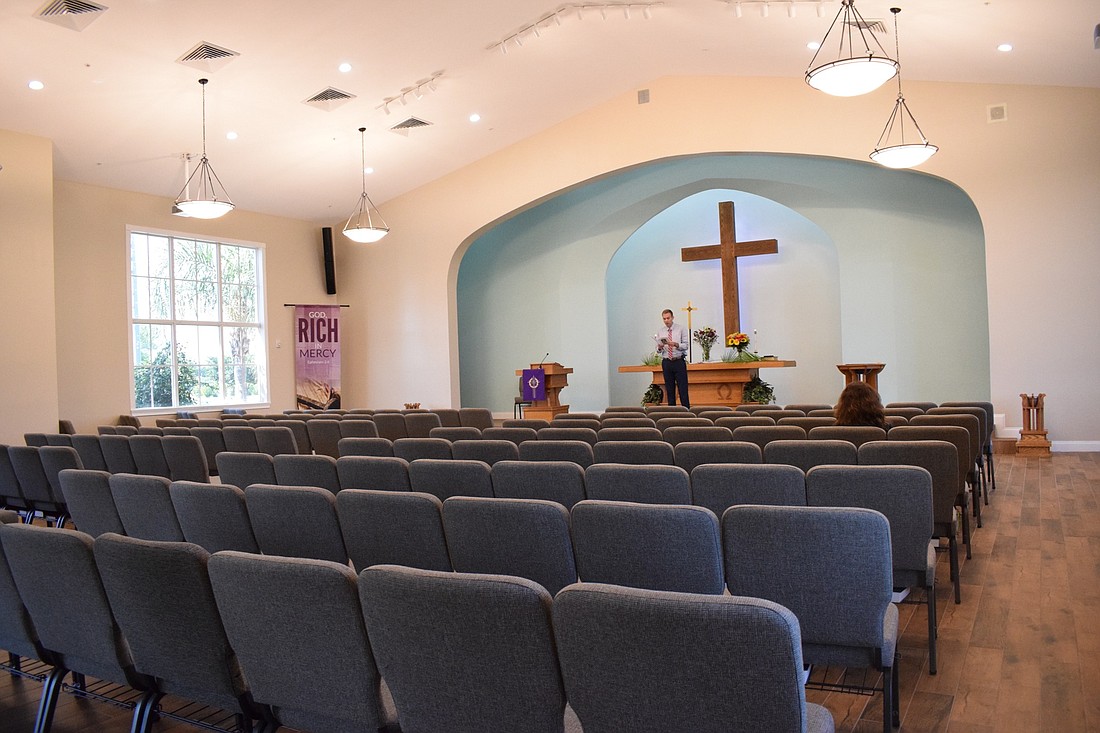- November 14, 2024
-
-
Loading

Loading

Pastor Caleb Free stood alone April 4 on the altar at Risen Savior Lutheran Church in Lakewood Ranch.
As he preached, he looked above dozens of empty chairs to a video camera resting above the entrance doors.
The room, which would normally be filled with about 140 people during a Sunday service, was empty except for Free and four other people.
After about 45 minutes, Free finished recording his service for April 5, a new normal for churches across East County.
Since concerns over the COVID-19 outbreak started, and the Centers for Disease Control and Prevention recommended the cancellation of large gatherings, local churches have moved services online.
Some churches have chosen Facebook Live to stream services, and others prerecord services and post them on their websites.
Churches including Bayside Community Church and Oasis Church are encouraging members to chat to have live engagement during services.
“We’re trying to create an interactive Sunday morning experience and use this opportunity with people being at home,” said Missy Parmenter, an associate pastor at Oasis Church. “Facebook and online church give us a platform where people can ask questions in real time and engage, and we’re able to answer those questions right away.”
Many churches are continuing small, community and youth groups online to encourage communication among members and offer support.
Church leaders and members said online services are crucial at a time when people can be isolated at home, and there is so much uncertainty.
“You look at all the things on the internet and on the news interviewing people on the front lines, and it’s so emotional,” said Vicki Schrimpf, a member of Harvest United Methodist Church. “It’s nice that we still have church on Sundays, so we still have that hope and know that God is there, and things will get better. We prefer to be in church with our church family, but this is the next best thing.”
For many church leaders, speaking into a camera is a dramatic change.
“When there’s no one there, it seems kind of strange, and it’s an adjustment,” Free said. “I think the more we do it, the more we’ll become used to it.”
Many church leaders try to insert moments of humor into their sermons, but it’s difficult for them to tell if what they said was funny if no one is there to laugh.
“As a preacher, you feed off the room, you read people’s faces, you sense when something doesn’t sound right,” said the Rev. Rick Hardison, lead pastor at Lakewood Ranch Baptist Church. “Humor is the hardest part, not that you try to go out and be funny, but there’s those unexpected moments of levity. You don’t know how stuff is landing on people. It’s a different dynamic.”
Parmenter said not being able to see everyone at church has made her more intentional with her relationships.
“In a way, we’re having to put our money where our mouth is,” Parmenter said. “For a long time we’ve said: ‘The church is more than a building. The church is the people.’ As pastors, we’re challenged to live that out right now, and it’s not as easy as a lot of us thought it would be.”
For church members, watching services at home allows them to feel connected to their church community.
Sue McIntyre, a member of Lakewood Ranch Baptist Church, and her husband, Dave, had some technical difficulties when trying to stream services for the first time. They enlisted their daughter, Stephanie, who lives in New Hampshire, to help them get everything set up.
McIntyre said online services are a wonderful substitute when they aren’t able to be in the church itself.
“I didn’t have to dress up, and I could go with whatever I was wearing,” she said with a laugh. “It’s better than listening on the radio, which we used to do.”
Although online services has its benefits, McIntyre said a challenge is not losing track of time and remembering to “go to church” at the usual time.
Sage Kamiya, a member of Lakewood Ranch Baptist Church, said watching services from his couch needs a different mindset than at church.
“We sit in our living room on our couch, which a lot of times is where we’ll sit and watch TV or movies,” Kamiya said. “You’re not getting your popcorn or your soda and sitting down to be entertained. It’s a little bit of a mental difference with the location. You need to sit down and prepare yourself to have some time worshipping God versus just being entertained.”
Kamiya said he enjoys still being able to hear a sermon and listen to praise music.
“It’s not quite the same with five people singing in a room when it’s normally 200, but at least we’re still able to feel a little bit part of the service,” he said.
No matter how well online services are working, a simple handshake, smile from across the room or greeting and saying goodbye to members of the church is what everyone misses about Sunday services.
“It’s not as good as being in person,” Kamiya said. “I think life is about relationships, and relationships are better in person versus online.”